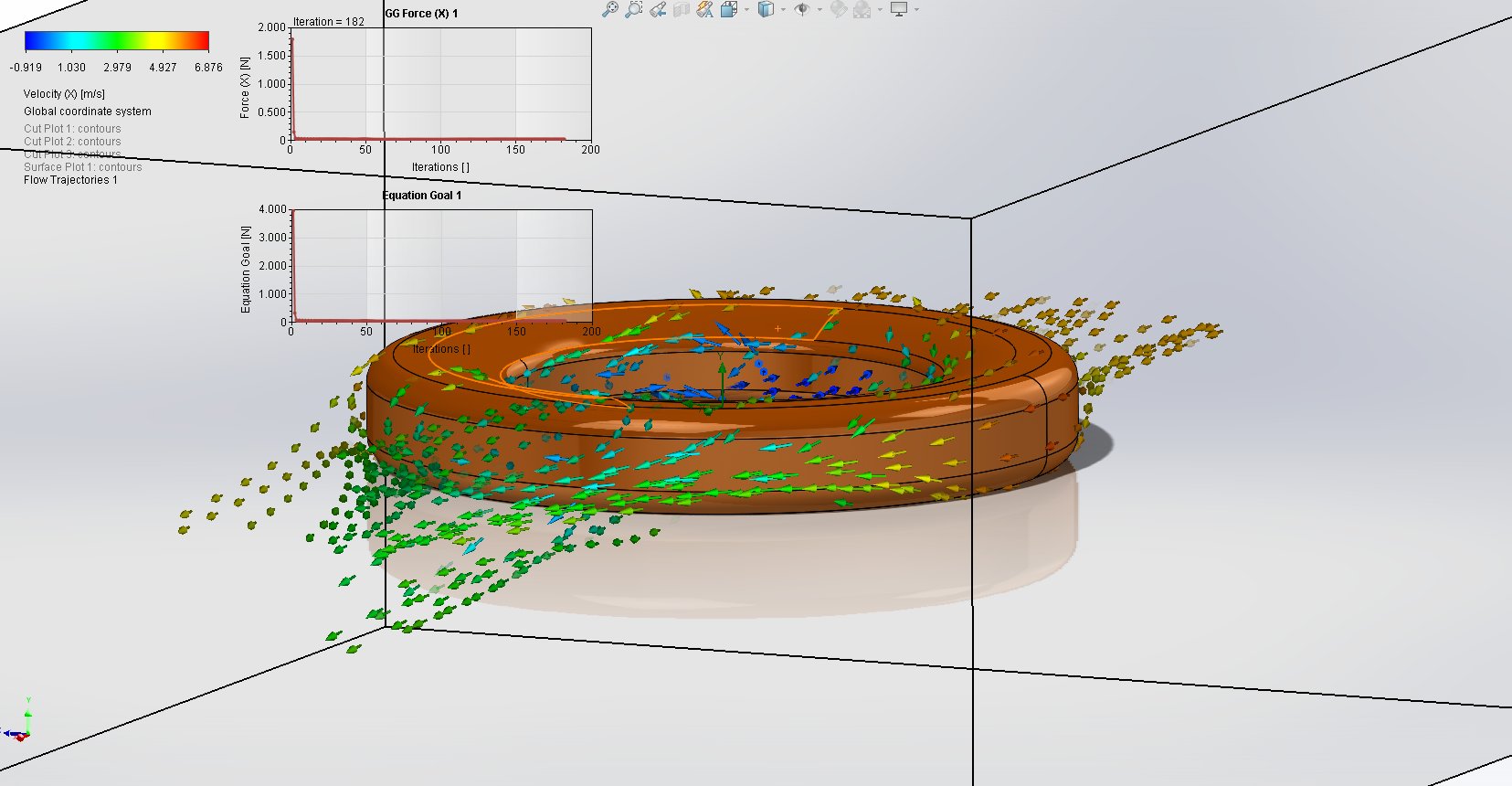Single Ring Cfd Formatted Report
| A CFD Write Up by Dev Patel |  |
|||||
|---|---|---|---|---|---|---|
| Robot Uprising FTC 14607 | Alexandria, VA |
|
Fluid Flow Simulation Project Report | |||
|
||||||
SOLIDWORKS Flow Simulation Project Report January 1, 2021
|
||||||
Learn more about SOLIDWORKS Flow Simulation  |
#
Table of Contents
1.4 Size of Computational Domain 1
1.5.5 Volumetric Heat Sources 2
General Information
Objective of the simulation: The objective of this simulation was to determine the drag coefficient of the Ultimate Goal FTC Ring, and to visualize airflow of the ring at launch speed.
Analysis Environment
Software Product: Flow Simulation 2020 3.0. Build: 4921
CPU Type: Intel(R) Xeon(R) CPU E5-1620 v3 @ 3.50GHz
CPU Speed: 3501 MHz
RAM: 32690 MB / 18463 MB
Operating System: Windows 10 (or higher) (Version 10.0.18362)
Model Information
Model Name: Drag-Ring.SLDPRT
Project Name: Project(1)
Project Comments:
Unit System: SI (m-kg-s)
Analysis Type: External (not exclude internal spaces)
Size of Computational Domain
Size
| X min | -0.121 m |
|---|---|
| X max | 0.159 m |
| Y min | -0.067 m |
| Y max | 0.067 m |
| Z min | -0.121 m |
| Z max | 0.121 m |
| X size | 0.279 m |
| Y size | 0.133 m |
| Z size | 0.241 m |
Simulation Parameters
Mesh Settings
Basic Mesh
Basic Mesh Dimensions
| Number of cells in X | 68 |
|---|---|
| Number of cells in Y | 32 |
| Number of cells in Z | 58 |
Analysis Mesh
Total Cell count: 124136
Fluid Cells: 124136
Solid Cells: 4836
Partial Cells: 2764
Trimmed Cells: 0
Additional Physical Calculation Options
Heat Transfer Analysis: Heat conduction in solids: Off
Flow Type: Laminar and turbulent
Time-Dependent Analysis: Off
Gravity: Off
Radiation:
Humidity: Off
Default Wall Roughness: 0 micrometer
Material Settings
Material Settings
Fluids
Initial Conditions
Ambient Conditions
| Thermodynamic parameters | Static Pressure: 101325.00 Pa Temperature: 293.20 K |
|---|---|
| Velocity parameters | Velocity vector Velocity in X direction: 5.500 m/s Velocity in Y direction: 0 m/s Velocity in Z direction: 0 m/s |
| Turbulence parameters | Turbulence intensity and length Intensity: 0.10 % Length: 1.905e-04 m |
Engineering Goals
Goals
Global Goals
GG Force (X) 1
| Type | Global Goal |
|---|---|
| Goal type | Force (X) |
| Coordinate system | Global coordinate system |
| Use in convergence | On |
Equation Goals
Equation Goal 1
| Type | Equation Goal |
|---|---|
| Formula | GG Force (X) 1*2/(0.0249*1.204*(5.5)^2) |
| Dimensionality | Force |
| Use in convergence | On |
Analysis Time
Calculation Time: 0 s
Number of Iterations: 182
Warnings:
#
Results
Analysis Goals
Goals
| Name | Unit | Value | Progress | Criteria | Delta | Use in convergence |
|---|---|---|---|---|---|---|
| GG Force (X) 1 | N | 0.025 | 100 | 0.000698638676 | 0.000630624299 | On |
| Equation Goal 1 | N | 0.055 | 100 | 0.00154074727 | 0.00139075133 | On |
Global Min-Max-Table
Min/Max Table
| Name | Minimum | Maximum |
|---|---|---|
| Density (Fluid) [kg/m^3] | 1.20 | 1.20 |
| Pressure [Pa] | 101290.97 | 101345.85 |
| Temperature [K] | 293.19 | 293.21 |
| Temperature (Fluid) [K] | 293.19 | 293.21 |
| Velocity [m/s] | 0 | 7.204 |
| Velocity (X) [m/s] | -0.919 | 6.876 |
| Velocity (Y) [m/s] | -4.386 | 4.578 |
| Velocity (Z) [m/s] | -3.491 | 3.434 |
| Mach Number [ ] | 0 | 0.02 |
| Velocity RRF [m/s] | 0 | 7.204 |
| Velocity RRF (X) [m/s] | -0.919 | 6.876 |
| Velocity RRF (Y) [m/s] | -4.386 | 4.578 |
| Velocity RRF (Z) [m/s] | -3.491 | 3.434 |
| Vorticity [1/s] | 0.20 | 1843.14 |
| Relative Pressure [Pa] | -34.03 | 20.85 |
| Shear Stress [Pa] | 0 | 0.85 |
| Bottleneck Number [ ] | 4.1642142e-13 | 1.0000000 |
| Heat Transfer Coefficient [W/m^2/K] | 0 | 0 |
| ShortCut Number [ ] | 9.7415646e-13 | 1.0000000 |
| Surface Heat Flux [W/m^2] | 0 | 0 |
| Surface Heat Flux (Convective) [W/m^2] | 0 | 0 |
| Acoustic Power [W/m^3] | 0 | 3.066e-10 |
| Acoustic Power Level [dB] | 0 | 24.87 |
Results
As shown in our analysis goals, we found that the overall Drag Coefficient at 5.5 m/s of the ring was about 0.055. We also found interesting results with the flow trajectory visualization. The air is at its fastest (6.2 m/s) as it scales the furthest edge of the cylinder. That high speed movement creates a wind vortex behind the cylinder. The spiraling of the airflow (dirty air) can create turbulence for an object behind it, especially if the object is travelling very close to it. In addition to the dirty air vortex, we also see a pool of slower air inside the cylinder cavity. This pool of air eventually leaks out from the top and bottom of the cylinder, speeding up and entering the vortex. This air pool may affect another cylinder or object travelling just above the cylinder. The air pool has a speed of almost .17 m/s, so it is much slower than the cylinder edge.

#
Appendix
Material Data
Engineering Database
Gases
Air
Path: Gases Pre-Defined
Specific heat ratio (Cp/Cv): 1.399
Molecular mass: 0.0290 kg/mol
Dynamic viscosity

Specific heat (Cp)

Thermal conductivity

 Dev Patel ∙
Dev Patel ∙